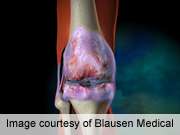The osteoporosis therapeutic strontium ranelate reduces radiographic and radiological progression of knee osteoarthritis, according to a study presented at the annual meeting of the American College of Rheumatology, held from Nov. 10 to 14 in Washington, D.C.
(HealthDay)—The osteoporosis therapeutic strontium ranelate (SrRan) reduces radiographic and radiological progression of knee osteoarthritis, according to a study presented at the annual meeting of the American College of Rheumatology, held from Nov. 10 to 14 in Washington, D.C.
Jean-Yves Reginster, M.D., Ph.D., from the University of Liège in Belgium, and colleagues conduced a double-blind, placebo-controlled three-year study involving 1,371 patients (63 ± 7 years; 69 percent female) with symptomatic primary knee OA (Kellgren and Lawrence grade 2 or 3, joint space width [JSW] 3.5 ± 0.8 mm) who were randomized to receive SrRan (1 or 2 g/day) or placebo.
The researchers found that SrRan correlated with less progression of cartilage degradation and a significantly smaller decrease in JSW (−0.23 ± 0.56 mm with 1 g/day; −0.27 ± 0.63 mm with 2 g/day; and −0.37 ± 0.59 mm with placebo), with no difference between doses. SrRan at both doses also correlated with significantly less radiological and radioclinical progression. SrRan at the 2 g/day dose led to significant reductions in total Western Ontario and McMaster Universities Osteoarthritis Index score, including the pain and physical function subscores and knee pain. SrRan was well tolerated, with 17 percent of the patients in each group reporting a serious emergent adverse effect.
"Results of the present trial show also [SrRan's] ability to reduce the progression of osteoarthritis," Reginster said in a statement. "This could be a major step in the global management of musculo-skeletal disorders in the elderly subjects."
Several authors disclosed financial ties to pharmaceutical companies, including Servier Laboratories, the manufacturer of strontium ranelate.
More information:
Abstract
More Information
Copyright © 2012 HealthDay. All rights reserved.






















